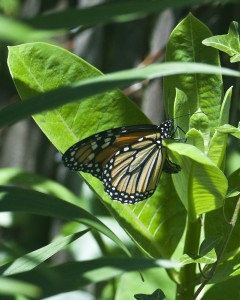From Canada to Mexico, gardeners are called upon to halt the decline of the Monarch butterfly populations across North America. The best way you can help is to fill your garden with Monarch’s favorite flowering nectar plants and milkweeds (Asclepias spp.). Plants should be sited in open full sun and moist well-drained soil. Avoid spraying pesticides within several hundred square feet of the designated butterfly planting.
Nectar plants are a food source for adult butterflies. Butterflies feed on the nectar which also helps to pollinate flowers. Select brightly colored flowers which are native to your area. Common nectar plants for monarchs include blackeyed Susan (Rudbeckia spp.), beebalm (Monarda spp.), anise hyssop (Agastache spp.), cosmos, aster (Symphyotrichum spp.), purple coneflower (Echinacea purpurea), lantana, Mexican sunflower (Tithonia), ironweed (Vernonia lettermannia), butterfly shrub (Buddleia spp.), marigold (Tagetes spp.), tall growing sedums (Sedum spectabile), Joe-Pye (Eupatorium spp.), blazing star (Liatris spp.), and zinnia.
Add larval-host plants to attract more butterflies to your garden. All butterflies need larval-host plants upon which to lay their eggs. In the case of Monarch caterpillars, the only host plants are the milkweeds (Asclepias spp.). Some favorite milkweed species include: common milkweed (A. syriaca) for large acreage gardens and swamp milkweed (A. incarnata) for smaller garden plots. Showy milkweed (A. speciosa), bloodflower (tropical milkweed) (A. curassavica), and butterfly milkweed (A. tuberosa) are some others.
For best results, add a varied number of flowering plants with staggered bloom times to keep butterflies grazing in your garden through the entire growing season. The local garden center may offer additional plants not listed here.
You can help rebuild the monarch population by planting colorful milkweeds and native nectar plants in your garden this spring.


 Posted in
Posted in 
